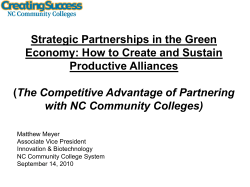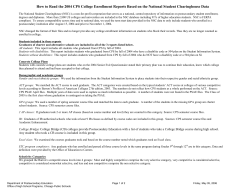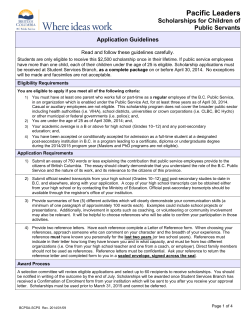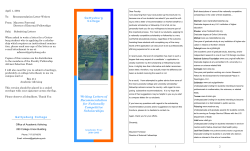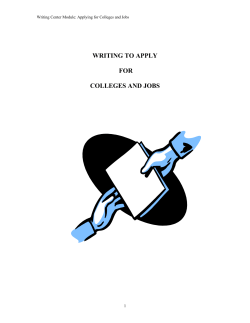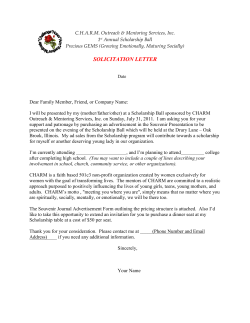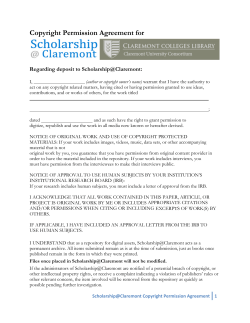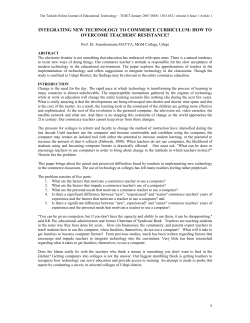
What to do and How to Plan to Get into College
What to do and How to Plan to Get into College It’s up to YOU! Sprague High School Post-Secondary Planning Handbook Take charge of your life! It’s up to YOU! Who can use this guide? You can! This guide has information about schools for the skilled trades, community colleges, four-year colleges, and other after-high-school options. Why should I use this guide? If you want to reach your goals after high school, check out the information because there may be something helpful in here. It’s up to you! How do I use this guide? Use it the way it works best for you. Take a peek at the table of contents. You can read it front to back or pop around for specific information. Who can help me out here? There are many people at Sprague who care about your future and are here for you. Talk to your teachers, counselors and administrators. Talk to your parents, too! Sprague Counselors Nancy Olsen A-Gh April DesJarlais Gi-Nh Cindy Devereux Ni-Z olsen_nancy@salkeiz.k12.or.us desjarlais_april@salkeiz.k12.or.us devereux_cindy@salekeiz.k12.or.us What do I do now? Take charge of your life! To have the most choices available to you upon graduating, do the best you can with grades and activities while you’re in high school. Use this book as a resource to help you reach your goals. 2 Table of Contents Graduation Requirements for Sprague High School Page 4 Post-Secondary Education Admission Requirements Page 5 AP Courses Page 6 College Credit Now Page 6 Post-Secondary Options Page 7 Planning for College Listed by Grade Level Pages 8-9 Selecting a School Pages 10-11 College Visits Pages 12-13 College Acceptance Page 14 Letters of Recommendation Page 14 College Admissions Terms Page 15 PSAT, SAT, ACT Pages 15-16 Food for Thought Page 17 Financial Aid Pages 18-19 Scholarships Pages 20-21 Career Search Page 22 Websites Page 23 3 Sprague High School Graduation Requirements Course Name English: Credits Needed (4 Credits) 4.0 Literature (Any course with an LL prefix) Writing (Any course with an LW prefix) Note: Does not include Drama, or Yearbook (3.00 credits) (1.00 credit) Mathematics: (3 Credits) Class of 2014 and beyond (all 3 credits are Algebra I and above) 3.0 Social Science: (3 Credits) 3.0 Science: 3.0 (3 Credits) Health: (1 Credit) .5 .5 Grade 9 – Wellness Skills I Grade 11 – Wellness Skills II Physical Education: (1 Credit) Grade 10-12 – P.E. Elective .5 .5 Applied Arts/Foreign Language: (3 Credits) 3.0 Grade 9 – Personal Fitness (Any courses in Art, Business/Computer Science, Engineering Tech, Family and consumer Studies, Foreign Language, Drama, Music, Yearbook, Video Production) Electives: (6 Credits) 24.0 Total (minimum requirements) Demonstrate Essential Skills: 2011 – 2012 Read and comprehend a variety of text 2012 – 2013 Read and comprehend a variety of text , write clearly and accurately 2013 – 2014 Read and comprehend a variety of text , write clearly and accurately, apply mathematics in a variety of settings In addition: o o o Completion of a Personal Education Plan (PEP) The PEP is an individual compilation of student achievements and experiences during high school that is updated throughout the year in each grade. The PEP serves as a great guide for filling out college and job applications and creating a personal resume. Demonstration of career-related learning experiences (CRLEs). Participate in experiences that connect classroom learning with real life experiences in the workplace, community, and/or school relevant to the student’s education plan Extended Application – Apply and extend knowledge and skills in new and complex situations related to career interests and post-high school goals 4 Requirements Career/Technical Training Technical schools are those that offer specific training in a skill, but do not necessarily offer a degree. Requirements vary for entrance. Most require a high school diploma and some require the ACT or SAT. Talk with a representative from the school for accurate information. Military Academy Most require the same coursework and level of achievement as selective universities. It is important to meet with a recruiter early in your JUNIOR year to begin the process. Community College Oregon community colleges require that students have a high school diploma, GED or are 18+. With permission, underage students can take classes at Chemeketa while still attending Sprague. Neither the ACT or SAT is required for entry; however, a placement exam is required of all students. Call the community college to schedule your placement exam. 5 Four-Year College/University Requirements Course Credits General Remarks English 4 Includes study of accepted English language, literature, speaking, and listening, and writing with emphasis on and frequent practice in Writing expository prose during all four years. Grades “C” or better. Mathematics 3 Complete coursework through Algebra II Theory with a strong Recommendation to take 4 years of math. Grades “C” or better. Science 2 Includes 2 credits each in two fields of college preparatory science such As biology, chemistry, physics, or earth and physical science (one Recommended as laboratory science). Grades “C” or better. Social Science 3 1 credit of U.S. History, 1 credit of global studies, and 1 credit of government/economics is recommended. Grades “C” or better. Second Language 2 Two years of study in the same second language. Grades “C” or better. Sprague High School College Credit Opportunities Advanced Placement Course Offerings: Sprague High School has a wide range of college credit opportunities available to students through its Advanced Placement Program. Students may receive advanced placement credit on their college transcript at many universities through the College Board Testing Service of the Advanced Placement Program. At a cost of approximately $84 per examination, students are assessed by the CBTS in the spring with a score of 1 – 5. Placement opportunities and/or credit granted will vary by university. Advanced Placement (AP) Courses offered at Sprague High School AP Biology AP English Literature AP Statistics AP Calculus BC AP Chemistry AP Physics AP Art History AP US History AP European History AP Spanish AP American Government 6 For a $30 fee per course you can begin your college education as a high school student. You don't pay college tuition or use valuable time in college reviewing what you have already learned in high school! When can I start earning College Credit? Students and parents should consider College Credit Now! opportunities in the freshman year of high school. Thoughtful forecasting of your high school program can result in several significant benefits. A carefully designed high school course of study will result in saved time and money. Where are these classes offered? Public high schools in Marion, Polk and Yamhill counties participate in the College Credit Now! program. How do I get started? Contact your high school teacher or counselor. They can give you specific information about eligible classes at your school. Enroll in class, register for credit, pay the $30 fee and complete the coursework. At the end of the course, your grade will be posted to your own Chemeketa College transcript. What can I take? Sprague High School offers a comprehensive curriculum, which includes a wide variety of advanced level courses. Courses in which students may apply for College Credit Now! Include the following: College Writing; Differential Calculus (BC), Integral Calculus (AP Calculus BC) Series Calculus & Linear Algebra (AP Calculus (BC) Technical Report Tech Writing, Mechanical Technology IV, CAD II, Architectural Drafting, CAD III, IV, 3D Solid Modeling, Intro to Microelectronics, Fundamentals of Microelectronics, Health Services I Medical Terminology I and II. Sports Medicine, Advanced Sports Medicine. (Please Note: High school course titles and Chemeketa course titles are not always identical. Contact the Curriculum Assistant Principal for specific course titles) What are my options? ~Types of Schools~ There are about 2,600 four-year colleges in the United States. There are 17 community colleges and over 60 different career/technical schools in Oregon alone. The choices are many, so how do you decide? Your decision is based on your career goals and what education is necessary to achieve those goals. Keep in mind that 85% of today’s careers require education/training beyond high school and that 20% require a 4-year college degree. Career and Technical Schools – Career and technical skills offer short-term training programs in specific skills. Some programs last a few weeks and others may take up to two years to complete. Costs vary greatly in regard to programs. Most schools are excellent. However, remember that they are private institutions with the goal of making a profit. Be sure to investigate the school thoroughly before sending a check. Community Colleges – Community Colleges, such as Chemeketa, offer many programs to fit the needs of the community. Students can take individual classes of 7 interest, or enter a two-year Associate’s Degree program. In order to save costs, many students attend community colleges for one or two years, then transfer and graduate with a Bachelor’s Degree from a four-year university. Any student with a high school diploma, GED, or is 18+ can attend. While an assessment/placement test is required, the ACT or SAT is not required for admission. Public Four-Year Universities – Public universities are larger than private universities. They, therefore, can offer a wide variety of majors because they are tax-supported and are generally less expensive than private colleges. (Out of state tuitions are generally much higher than in state.) Private Four-Year Universities – Generally, private colleges and universities are smaller and more expensive than public ones. Often, students receive more individual attention and smaller class size. Private colleges are traditionally more generous with financial aid and do not have as many governmental adherences to dispersing funds. How do I keep all this information straight? File Folders – Have a folder for each option you’re considering. “College search” might be one label or “Career Options” might be another one. At the least, have a big box to put everything in, so you know where it is when you need it. Calendar – Deadlines come up fast. Mark your master calendar for deadlines having to do with test registration, student aid, scholarship and school applications, and other important dates. What can I be doing now to reach my goals? Freshman Year Your two biggest questions might be, “How can I afford college or training?” and, “What do I have to do for a school to accept me?” Schools expect parent contribution for expenses, so a regular savings plan beginning immediately is advisable. The best thing you can do for financial assistance and being accepted where you want to go is to become the best student possible, beginning right now. • • • Grades matter. Oregon universities no longer accept C- or below in core classes. They want to see that a student can succeed in basic courses. The grade point average for acceptance into Oregon universities ranges from 2.75 to 3.25. If your goal is to attend a four-year school, then your grade point average needs to be around 3.25 or higher. Grades matter. Scholarships can be used for skilled trade training, as well as for college. However, there is often a minimum grade point average to attain scholarships. Activities matter. Are you giving to a cause beyond yourself? Are you on a sport team, in a club, or volunteer outside of school? Activities are a way to get involved, to explore your interests and to do things you enjoy. Being involved shows colleges and scholarship donors that you can be responsible, committed, and that you care about your community. 8 • • An open mind is important. Keep your options open. Remember, the better grades you earn and the more involved you are, the more choices you create for yourself. Explore your career interest during your freshman year. How many choices will you create for yourself by getting the best grades you can and by being involved with something you enjoy? Sophomore Year • • • • • • • • • For practice, take the Preliminary SAT (PSAT) in the fall. It is offered only in October (usually the third Saturday), so mark your calendar. Stay (or get) involved with community and/or school activities that you enjoy. Challenge yourself to be the best student you can be! If your goal is to attend a four-year school, then your grade point average needs to be around 3.25 or higher. Review and continue to explore career paths that interest you. Keep up that savings plan if possible. Start two folders: One for scholarship information and one for schools/training. Visit universities, colleges and career schools that interest you. Use the Internet to search college databases. A good start is College Board. This is the company that does the AP, SAT, and PSAT tests. Theirs and other websites are listed on the last page of this guide. Use the internet to search for scholarships. The last page of this guide lists websites. NOTE: Beware of scholarship/college search services. If a service “guarantees college money” or “guarantees” anything for a fee… walk away! You have access to the same scholarship search information they do – for free! Junior Year • • • • • • • • • • Take the PSAT. It is offered in October only, so mark your calendar. Take the ACT college entrance assessment for practice. (Most schools take either test’s scores.) Search for and request scholarships, especially off of the Internet. See Sprague website for scholarship searches. You can request applications any time by writing to the donor. What better summer project this year? Take challenging courses, while maintaining the best grades possible. AP classes are indeed valued (and sometimes scored higher on college applications) than regular classes. Take them if you can handle them. If your goal is to attend a four-year school, then your grade point average needs to be around 3.25 or higher. Take the ASVAB Career Exploration Assessment. This is the military exam that assesses your proficiency in many areas. It allows you access to the entire career exploration program. Your scores are released to the military ONLY with your permission. The test is free, and the program is free as well. If your goal is to attend a military academy, you must begin the application process early in your junior year. Continue to search for scholarships and for schools that fit your interests. Narrow your school choices to three or four. Continue to search for the school that’s right for you. Visit, visit, visit, if you can! At the least, meet with the school representatives that visit our campus. See Sprague website for dates/times schools are coming, and you can sign up to meet with them. 9 Senior Year Yeah! You’re almost there! There is a lot to do during your senior year, but don’t panic! Now is the time when your calendar comes in very handy. Those two burning questions might still be flaming, “How do I get in to the school I want?” and, “How will I pay for my education?” Remember that all seniors face these questions each year and somehow manage to survive the process of applying to schools and financing their education. • • • • • • Get out your calendar and write in all the appropriate deadlines! (Test registration, scholarships, applications, FAFSA, etc.) Schedule challenging classes for your senior year. Schools look for steady advancement in classes. Also, taking a year off of math, for example, might ill-prepare you for that first math class in college. Narrow your school choices to 3 or 4. Include one “safe” school, meaning a school where you are sure to be accepted. Check the website for visiting schools. Sign up to meet with school representatives. Check the website for SCHOLARSHIPS at least once a week throughout the year. File your FAFSA online as soon after January 1 as possible at www.fafsa.gov. How Do I Decide? ~Selecting A School~ READ……………..and gather information on colleges that interest you. Organize it! ATTEND…….....college visitations. CONSULT……...with your counselor, parents and others. WRITE………......to college Admissions Departments to request information. SURF……………….the websites of the colleges in which you are interested. When you’re considering schools, take a look at the factual information, like programs, housing, and location; but equally important is the feel or atmosphere of the place, which is why visiting the campus is such a good idea. The following checklist is designed to help you identify those characteristics that will be important to you in selecting a particular school or college. Share your checklist with your parents and use it as a guide as you search for the school that’s right for you. • Type of institution Public two-year college Independent four-year college or university Public four-year college or university Career/Technical School Certificate Program Military Academy Geographical Location Urban environment Rural environment Within 50 miles of home Large city over 300,000 • 10 Medium city of 50,000 – 300,000 Small city/town of 10,000 – 50,000 Within Oregon Outside Oregon Total enrollment Very small: under 1,000 students Small: 1000 – 6000 students Medium: 6000 – 10,000 students Large: 10,000 – 20,000 students Very Large: 20,000+ students Student Body Church related Secular Broad spectrum of diversity Homogenous Housing Residence halls for men only Residence halls for women only Coed residence halls Academic halls Freshmen may choose their own halls Freshmen required to live on campus Greek system- fraternities and sororities Apartments and /or houses available Live at home and commute • • • • Cost $1000 – $5000 $5000 –$13,000 $13,000 –$22,000 Over $22,000 Programs of study Agriculture/Natural Resource Architecture Biological Studies Business/Management Communications Computer/Information Sciences Education Engineering Fine and Applied Arts Letters (English, Philosophy, Speech) Interdisciplinary Studies Health Service Home Economics Human Affairs Physical Sciences Psychology Public Affairs Mathematics Social Sciences Technology Foreign Language Other Undecided Special Programs Honors program • • 11 Independent Study Minority or low income student programs Study abroad Internships and post-graduate job placement Military Training Air Force ROTC Army ROTC Army Flight Training Navy/Marine ROTC Campus Life Religious organizations Greek system Intercollegiate athletics Band, orchestra, choral Minority student unions Movie/film series on campus Political organizations Theatre Intramural athletics Radio station Newspaper Student government • • Some major myths about college selection Myth #1: I need to decide on my career before I can choose a college. It’s important to have goals and be aware of your interests, but you limit yourself drastically if you try to choose a specific career too early. The average college student changes majors two or three times in the course of four years of college. For the time being, make use of the career exploration programs available through the Career Center and your path will eventually become clear. Myth #2: We can only afford a low-priced school. Students often rule out some colleges because the total cost of tuition, room and board appears to be more than the family can afford. This is rarely the case when all sources of financial aid are explored. Private colleges in particular offer significant amounts of financial aid in order to attract students from all income levels. College Campus Visits What happens during a visit? Maybe nothing will happen if you just drop in! Make sure to: 1) Plan ahead. Make an appointment with the Admissions Office before going and ask about campus open house events. 2) Allow plenty of time while you’re there. If need be, arrange an overnight stay. Ask every college in which you are interested to send material on campus visits. Any or all of the following may be available to you: 12 • • • • • • • • Campus tours – Some require an appointment; some, you can drop in. Interview with an Admissions Counselor – Usually requires 2 weeks notice. Attending classes – Arranged through Admissions Meeting with faculty and coaches – This cannot be done last-minute! Arrange the meetings through Admissions and through the Athletic Department. Overnight stay in residence halls – Requires advanced notice; an excellent way to really get the “feeling” of the place. Special visitor open houses or weekends – These are major events put on by the colleges, bringing together all the campus resources for you to access. Sometimes, airfare will be partially paid, with a possible full refund of airfare if you enroll. Personal time to look around – Do some exploring on your own. Check out all of the facilities: dining halls, gym, library, etc. Go to the department of your interest area and see if you can talk to one of the professors about the program. Talk with students informally on the campus. They will give you an honest, realistic student’s point of view about the school. When should I make my visits? Visit at any time, beginning in your sophomore year if you like, preferably when students are still in session to get the full feel of the campus. Be aware of dates when students are in final exams (this is not a good time to go.) What should I ask when I get there? What should I ask a representative who visits Sprague? The following are sample questions to ask an admissions counselor, a visiting representative, or a student who lives on campus: • • • • • • • • • • • • • • • • • • • • • • What is unique about your institution? What type of student is happiest there? What type of student is most successful there? What percent of classes are taught by professors? By teaching assistants? What are the most popular majors and why? How many college credits can I earn from my AP courses and tests? What is most important in getting accepted to your college? What are the chances of getting accepted into your college? How large are the classes, specifically the freshman classes? How easy is it for freshman to get the classes they want? How many freshmen return for their sophomore year? How easily can I access a computer? What kind of academic support is there for students? How tough is it to earn a degree in four years? Do you feel you’re getting your money’s worth? How much do you have to study? Which facilities are best? And worst? What are the residence halls like? What is the food like? What is the city/town/surrounding area like? What do students do in their free time? What do you like best about school? Least? 13 What are colleges looking for? Colleges want well-rounded students who will be successful at their institution. Meaning, they want students who will not only show up for their freshman year, but who will do well academically, get involved with the campus, add value to their campus through diversity and talents, and, most importantly, graduate from their college! Colleges are looking for these attributes in their applicants: • • • • • • • • A strong academic record, specifically your grades and the level of classes you’ve taken. Students who will thrive in the campus setting Interesting people with diverse experiences Talented students Students who are serious about their studies Students who have contributed to something “outside” themselves, like sports, volunteering, or other involvement GPA and SAT/ACT scores A solid academic schedule your senior year Selective colleges will be looking for an excellent academic record in the most challenging courses available to you. Essentially, colleges are looking for a reason to ACCEPT, not deny you! Tips On Getting Accepted • • • • • • • • • • Always clarify circumstances that explain poor scores or grades without apologizing. Plan a budget for applying. Application fees range from $10 to $75. Determine deadlines. Mark them on your calendar, and stay on top of them. Begin gathering your materials early. o Special note: If you need letters of recommendation, start early! Give your recommending parties a deadline of three weeks before you really need the letters. Many students have not received their deserved benefits because letters of recommendation have not arrived on time or have not arrived at all. Order your required transcripts early through the Business office, to ensure you have them before deadlines. Transcript request form is available on line. Spend quality time on your essay. Your essay may indeed be THE deciding factor of whether you’re admitted. Colleges want to know you as a person, not as a number! Many schools have on-line applications, many of which will waive the application fee if you apply on line. Request applications by phone, letter or email to the school. You can also use the Common Application, found at www.commonapp.org, for many schools. Make a copy of everything you send in your application packet. If paying the application fee is a hardship, contact the school directly to inquire about application fee waivers. 14 Letters of Recommendation for College and for Scholarships • • • See the Sprague website for the Request for Recommendation form, or see the Guidance secretary. Fill out the form and give one to each person from whom you’re requesting a letter. Be sure to choose a counselor, coach, teacher, advisor or family friend who knows you well. Allow 3 weeks for them to write the letter. If the letter is to be sent directly from the writer to the institution, be SURE that they do it by the deadline! There definitely have been times when students have not received scholarships simply because their materials, specifically letters of recommendation, were not submitted by the deadline. Application Terms Application Deadline: Most colleges have a specific date by which applications must be at the college. In some cases the colleges will state that the application must be post marked by that date. Some universities offer an “Early Decision” process, with application deadlines due early in the school year. Online Applications Common Application CollegeNet Princeton Review www.commonapp.org/ www.collegenet.com www.embark.com Candidate Notification Date: Colleges will tell you in their literature the date they will let you know of their decision. Candidate’s Reply Date: This is the date by which you must decide and convey to the college of your decision to attend. (May 1 is the National Date) It is courteous to the other colleges to let them know that you are not attending. Early Action: A small number of colleges have early action policies. This means that you may apply early, be admitted perhaps before December of your senior year, but not be obligated to let them know of your decision before May 1. Rolling Admission: Some colleges have a policy where, as soon as they have your application and supporting documents, the college will make a decision within a few weeks or a month. Regular Admission: Application materials are to be submitted no later than the specified deadline date printed on the application form. Admission responses are usually received March 15th – April 15th. Wait List: 15 If a college places you on the wait list, it means that you are a strong candidate, but that they did not have room for all of their candidates. A wait list usually means you still may have a chance. If you are on the wait list at your first choice college, you will need to talk to a college counselor about what you can do to enhance your chances of acceptance. PSAT, SAT & ACT ~Admissions Tests~ Almost all four-year colleges and universities require incoming freshman to take college entrance examinations as a way of verifying students’ readiness to enter college. Colleges and universities are quick to point out that grades and the rigor of courses taken in high school are the best indicators of preparedness and examinations are used more as supplemental information. Good scores can help in gaining entrance into highly selective schools and in scholarship competitions. Scores can also be important for athletic participation in NCAA Division I and II institutions. Most schools will accept either SAT or ACT scores. However, some will only accept one test score. Be sure to check directly with the schools you are considering about what test they prefer. Preliminary Scholastic Achievement Test/National Merit Scholarship Qualifying Test (PSAT/NMSQT or PSAT) The PSAT is a practice test for the SAT. It is also the qualifying test for juniors for the National Merit Scholarship. Sophomores and juniors are encouraged to take the test. What’s the difference between the SAT and ACT? – The ACT (American College Test) is content-based, meaning you will be tested more on what you’ve learned in your classes. The ACT tests in the subjects of: English, Reading, Math, and Science. Check with your selected college to see if they require the ACT Writing test which is also available. The SAT (Scholastic Aptitude Test) tests in the areas of Math, Critical Reading and Writing. It is more of an analytical reasoning test. Students get ¼ point counted against them for wrong answers (guessing). What is the SAT Subject Test? – SAT Subject Tests are on specific topics, such as a foreign language. Some colleges will require SAT Subject Tests for specific majors. Check with the schools to which you are applying to find out what the requirements are. When should I test? – It is recommended that you take both the SAT and the ACT the spring of your junior year. This serves to find out which test is better for you and to find out if you need to make improvements and test again your senior year. Seniors need to test in the fall to meet application deadlines. Where do I test? Go to the College Board website to schedule your test and select a testing site. Chemeketa Community College is the local testing center for the ACT. Fees - If you register on time, the SAT fee is $45.00. The ACT plus Writing is $47.00. Late registrations will cost more. 16 Timing – Registration deadlines are 4 to 5 weeks prior to the test date. Scores are released about four weeks after you take the test. How do I study for these tests? – Both test websites offer testing hints and study tips. There are a number of books available at any bookstore, offering test preparation as well. The Library has some resources that can be checked out. Two helpful websites are: http://kaplan.com/ and http://petersons.com. The best way to do well on the tests is to practice. Take practice tests from books, take the PSAT, and take the tests more than once. Visit collegeboard.com for sample tests and questions. Most colleges and universities will accept the best of your scores. How to register It is best to register online. For the SAT go to: www.collegeboard.com. For the ACT go to: www.actstudent.org. A limited number of hard copy registration packets are available from your counselor. You will need Sprague High School’s code -- 381043. Food for thought . . . B.B. King The you. beautiful thing about learning is that no one can take it away from Epictetus Only the educated are free. Anon Fear not that your life will someday end. Fear only that you do nothing with it. Dr. Seuss I like nonsense; it wakes up the brain cells. 17 Thomas Edison Opportunity is missed by most people because it is dressed in overalls and looks like work. Babe Ruth Never let the fear of striking out get in your way. Unknown If you study to remember, you will forget, but, if you study to understand, you will remember. Confucius Our greatest glory is not in never falling, but in rising every time we fall. Thomas Edison I have not failed. I've just found 10,000 ways that won't work. How Do I Pay For My Education? ~Financial Aid & Scholarships~ Financial Aid – Financial aid is money that is given, earned, or loaned to help students pay for their education. The majority of financial aid comes from the government and from the colleges. There are four forms of financial aid: 1) Grants: Money that is given to the student, usually because of financial need. 2) Scholarships: Money that is awarded because of exceptional academic achievement, an outstanding talent or skill, and/or financial need. 3) Work Study: Money the student earns by working at a college job, usually 10-15 hours a week. 4) Loans: Borrowed money that must be repaid. Need-based and Merit-based Financial Aid: Need-based financial aid is money that goes to families who do not have sufficient financial resources to pay for college. When determining eligibility for need-based financial aid, the family’s financial situation is the only thing that is considered; a student’s academic record is not a factor. Merit-based Financial Aid: Students are awarded merit-based financial aid based on outstanding abilities, talents, and/or accomplishments, or ties to an organization such 18 as a service club or labor union. When awarding merit-based aid, the financial situation of the family is usually not considered. Some financial aid awards consider both need and merit. Students should never assume that a particular school is financially out of reach for them. Affordability should be determined only after applying for financial aid and examining each school’s financial aid package. Free Application for Federal Student Aid (FAFSA) online @ www.fafsa.gov • Every student and his/her family should fill out the FAFSA regardless of income. • The FAFSA is the most important form to complete to receive financial assistance for your education. • The FAFSA should be completed as soon after January 1 as possible. If you need to, use estimates to complete the form. Filling out the FAFSA is much like filling out a tax form. It asks parents and students for information about income, assets, debts, etc., from the previous year. The form is available beginning in December, but it is much better to submit the FAFSA online. FAFSA steps: 1) Get your PIN. Both you and your parent/guardian need to get a PIN in order to sign your FAFSA online. Go to: www.pin.ed.gov 2) Once the government assigns your PIN’s, you can then fill out the FAFSA at: www.fafsa.gov. Be prepared to know to which schools you would like information sent. Even if you are only considering one school, include it to receive your information. 3) You will receive your Student Aid Report (SAR) via email link in about one week. Be sure to review the information and correct any information. You can access your account and make changes as necessary, especially after receiving your tax information. 4) The SAR will state what your Estimated Family Contribution (EFC) is. This is the amount schools will expect the family to contribute toward expenses the following year. The school will then try to make up the difference between the EFC and cost of attendance through what is available through financial aid. Excellent sources for financial aid information are: • www.studentaid.ed.gov is the website for a plethora of student funding information. • 1-800-4-FED-AID is the number to speak to a financial aid representative. 19 5) Each school listed on your FAFSA will receive your information. With that information, the individual schools then compile your Financial Aid Package. 6) The schools may have their own financial aid/scholarship forms they want you to complete. Do exactly as they specify, and be sure to pay close attention to deadlines for these forms! 7) Each school will contact you if they need further information to determine your financial aid package. Each school then sends you an acceptance offer (if you qualified) and your financial aid package offer. You can use this information in determining which school you would like to attend. The PROFILE – The PROFILE is a one-page needs analysis form that provides colleges and scholarship programs with additional information on a family’s financial situation. Information from the PROFILE is used in awarding nonfederal student aid funds. The College Scholarship Service (CCS) provides the PROFILE. Colleges that require the PROFILE will list it in their application requirements. The two ways to get the PROFILE are: • Go to www.collegeboard.com, • Call CSS PROFILE at 800-239-5888. Scholarships Scholarships are based on merit and/or need. Three basic rules apply to scholarships: 1) Start with local (community or state) scholarships 2) The more specific as to how you meet the eligibility criteria, the better. 3) Many scholarships can be used for community colleges and/or career schools. Academic – Most academic scholarships are awarded to students who have a 3.4+ GPA and a 26+ ACT or 1200+ SAT score. While these factors are important, most scholarships are awarded to students who are also involved in school and community activities. Scholarship committees look for depth of commitment in activities (i.e., four years in band, or three years of volunteering) and evidence of leadership traits (i.e., organizer of an event, class official). Minority – Schools want a diverse student body, therefore they often offer scholarships in order to increase their diversity. Check libraries and bookstores for resources on minority scholarships. The Big Book of Minority Opportunities is one such resource, as well as the two websites: www.blackexcel.org; and www.rspfunding.com. Athletic – Sports can be a valuable asset to students, if they have highly sought-after talent. Basic information on athletic scholarships can be found at the associations’ websites. Be sure to contact your athletic director and/or counselor early in your JUNIOR year to access the right procedure for sports scholarship opportunities. NCAA (National Collegiate Athletic Assn., over 950 member colleges) – Division I and Division II colleges can offer athletic scholarships; Division III (mostly smaller, 20 private colleges) cannot. There are very specific requirements for the NCAA Clearinghouse. Go to: www.ncaa.org. NAIA (National Assn. of Intercollegiate Athletics, over 300 member colleges) – NAIA colleges can offer full or partial scholarships. Go to www.naia.org. NJCAA (National Junior Collegiate Athletics Assn., 500 junior colleges) – NJCAA Division one and Division II colleges can offer scholarships; Division III cannot. There are no academic eligibility requirements for junior colleges. Go to: www.njcaa.org. Talent – You must understand that talent scholarships are awarded to students who have a truly outstanding talent, as the competition for such scholarships is fierce. Students with the goal of attaining a talent scholarship should develop a professional-looking resume, documenting performances, awards, etc. Check with your individual colleges for their specific talent scholarship guidelines. Local – The Sprague Website lists all of the local scholarships that are sent to the school. Check the web site at least once per week, from the beginning of school through May for local scholarship opportunities. Keep the following in mind as well: • • • Colleges award most of the scholarships, and private colleges generally award more scholarships than public schools. A one-year scholarship is for one year only, while a renewable scholarship can become a four-year scholarship. Outside scholarships must be reported to the school’s financial aid office. Other Sources of Aid The Military – The United States military is the nation’s single largest employer. It offers training and employment in over 2,000 job specialties, 75% of which have civilian counterparts. The following numbers and websites will get you started: Army Navy Air Force Marines 1-800-USA-ARMY 1-800-USA-NAVY 1-800-423-USAF 1-800-MARINES www.goarmy.com www.navy.com www.airforce.com www.marines.com The Montgomery GI Bill – Enlistees on active duty can take $100 of their pay each month and contribute up to $1,200 into a college fund. If an enlistee puts $1,200 into the fund, he/she will receive over $20,000 to pay for education. Military Academies – If you qualify, you can receive full tuition and fees to a four-year college, plus a stipend. Academy graduates enter the military as officers for a specific number of years after graduating. Begin this process early in your junior year. Tuition Assistance – Active-duty enlistees can attend area colleges with up to 75% of the tuition paid by the government. 21 National Guard and Army Reserves – For the most up-to-date information, talk to a recruiter. Tax Incentives – The “Hope Scholarship” Tax Credit and the Lifetime Learning Credit are both tax deductions for college costs. Go to the following websites for more information: www.ed.gov/updates/97918tax.html and www.irs.gov. The Educational IRA allows taxpayers to put in up to $2,000 per year for each student under the age of 18. AmeriCorps – AmeriCorps is a national service program. Participants are paid minimum wage, and they receive an education award that can be used to pay for college. Workers help communities with their education, public safety, human services and environmental needs. You earn minimum wage while working and an award of $4725 for each full-time year of service. Western Undergraduate Exchange Program – This program may be the bestkept secret in considering colleges! Visit the website for specific state’s requirements at www.wiche.edu WUE is the Western Undergraduate Exchange, a program of the Western Interstate Commission for Higher Education (WICHE). Through WUE, students in western states may enroll in many two-year and four-year college programs at a reduced tuition level. WUE tuition is considerably less than non-resident tuition. What Career Do I Pursue? It is not imperative that you know exactly what you want to study if you’re attending a four-year college. By taking courses that interest you and accessing career exploration resources, your direction will eventually become clear. However, if you plan to attend a community college, or plan to enroll in a skilled trade program, your career goal must be specific. What Can I Do With My GED? Earning a GED is not a dead end; it is an achievement and an opportunity to pursue your goals. Once you earn your GED, your options are many. You can enroll in a community college if your GED average is 450, or go straight to a 4 year college/university if your average is slightly higher. Career Information Systems (CIS) Sprague High School subscribes to this internet site specifically designed for you to explore career options, college majors, college information, occupation wages, career planning, and many other features that help you plan your career, find the educational or training institution which best suits you and reach your post-secondary goals. To access CIS: • Type into the a web address: http://oregoncis.uoregon.edu • Select: Internet for CIS • Username: Olympians06 • Password: allstars 22 Remember To: 1. Take time to think about what you like to do; dream and imagine ideal careers. 2. Challenge yourself in high school, but don't overwhelm yourself. 3. Work, volunteer, or otherwise gain some experience. 4. Get as much education as you can. 5. Talk with as many adults as possible about careers and colleges. 7. People change; don't feel locked into any college or career now. 8. Don't let anyone control your dreams and ambitions. 10. Never stop learning… read, grow, and expand your mind. High school is a real transition time, as you move into adulthood and the more adult issues of work, careers, and college. It should be a time of growth as well as a time of challenge. Have fun, but get the best education you can so that you are positioned to take advantage of further educational opportunities… and no matter where you go after high school, never stop learning and growing. (Taken from Dr. Randall S. Hansen, Publisher, CEO, and Author of many career-based publications) 23 Higher Education Search Sites College Board College Net College View Peterson’s The Princeton Review The Old School College Answer US News & World Report National Center for College Navigator www.collegeboard.com www.collegenet.com www.collegeview.com www.petersons.com www.princetonreview.com www.theoldschool.org www.collegeanswer.com www.usnews.com/education www.nces.ed.gov/collegenavigator This site is a government site. Any school that receives financial aid must submit information to the government. Therefore, this site does not have paid advertising… a very nice attribute. Financial Aid Sites FAFSA (Free Application for Student Assistance) www.fafsa.ed.gov (Do NOT go to “fasfsa.com”! It is NOT the official website.) Student Aid on the Web www.studentaid.ed.gov National Assoc. of Student Financial Aid Administrators www.finaid.org Scholarship Opportunities and Search Sites Fast Web Oregon Student Assistance Commission GoCollege Sallie Mae (College Answer) College Net School Soup College Bound Scholarship Coach Scholarships www.fastweb.com www.osac.state.or.us www.gocollege.com www.collegeanswer.com www.collegenet.com www.tuitions.com www.collegebound.com www.scholarshipcoach.com www.scholarships.com Standardized Test Registration SAT (Collegeboard) ACT www.collegeboard.com www.act.org Standardized Test Preparation (Free) Oakwood Publishing No 2 www.testinfo.net/sat.htm www.number2.com/ Regional and Unique College Organizations Assoc. of Independent California Colleges/Universities Assoc. of Universities and Colleges of Canada Council for Christian Colleges/Universities Oregon University System Western Undergraduate Exchange University of California www.aiccu.edu www.aucc.edu www.cccu.org www.ous.edu www.wiche.edu www.ucop.edu College Athletics Information NCAA NAIA www.ncaa.org www.naia.org 24
© Copyright 2025
